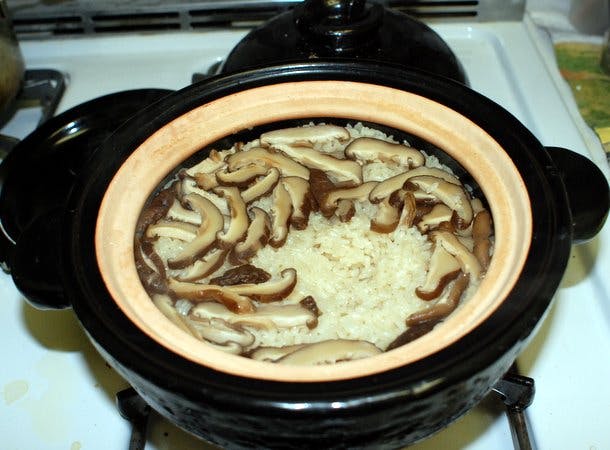
Rice Bliss: A Rice Donabe
Learn about traditional donabe and how to cook delicious rice dishes using the specialized rice donabe. Find out where to get an Iga rice donabe and how to properly season and care for it. Discover the recipe for flavorful shiitake mixed rice and the benefits of using haiga rice for cooking.
When I visited a traditional donabe maker in Iga last fall (see my post), I brought home a specialized rice donabe, an earthenware vessel designed specifically to cook rice on the stove top -- in other words, a traditional pot adapted for modern lives. But I haven't used it much, to be honest. Until now...
When I mentioned my rice donabe to my friend the journalist Keiko Tsuyama, she said she wanted to cook her favorite shiitake gohan in it, shiitake mixed rice. We invited a dozen or so friends for a dinner party-slash-rice tasting, and I carried my donabe on the subway to Keiko's place uptown.
This donabe is an amazing vessel. It has two lids to control the circulation of steam and is made from the remarkable heat-conducting porous clay that Iga has been famous for, for centuries.
Cooking Rice in a Donabe
Ingredients:
- 2 cups white rice
Equipment:
- Donabe (Japanese clay pot)
Instructions:
-
Preparation:
- Wash the rice thoroughly, drain, and then let it rest for 30 minutes in a colander covered with a cloth. This step is crucial for achieving the perfect texture.
-
Cooking:
- Transfer the washed and rested rice into the donabe. Add an equal amount of water (2 cups for 2 cups of rice).
- Cover the donabe with both of its lids. This helps maintain an even cooking temperature and pressure inside the pot.
- Set the heat to medium-high. Cook until you observe steam escaping from the outer lid, which usually takes about 15 minutes. The appearance of steam indicates that the water has reached boiling point and the rice is cooking properly.
- Allow the steam to escape for an additional 3 to 5 minutes. During this phase, the rice begins to develop a wonderful caramelized aroma, a unique characteristic of cooking with a donabe.
-
Finishing:
- Turn off the heat and let the rice sit in the donabe, covered, for 20 minutes. This resting period allows the rice to finish cooking in its steam, ensuring each grain is fluffy and fully cooked.
Techniques and Their Purposes:
- Resting the Washed Rice: Allows the grains to absorb water, leading to better texture upon cooking.
- Using Both Lids of the Donabe: Creates a seal that helps in building up the right amount of pressure and steam for cooking the rice evenly.
- Monitoring Steam: The steam release is an indicator of the cooking process and helps in timing the cooking perfectly.
- Resting Period Post-Cooking: Essential for allowing the rice to settle, absorb any remaining moisture evenly, and enhance the flavor with the donabe's natural caramelization effect.
That's it. Now that I've gotten the hang of it, it takes about as much time to prepare rice in a donabe as it does in a high-tech rice cooker. The difference is the taste - an electric rice cooker can't possibly match the perfectly flavored rice produced by the donabe, with its delicious veneer of okoge, or caramelized rice crust. And the aroma? No comparison.
# **Keiko's Shiitake Rice in a Donabe**
## Ingredients:
- Dried shiitake mushrooms
- 3 cups rice
- 3 cups shiitake dashi (from soaking the dried shiitake)
- 2 tablespoons soy sauce
- 3 tablespoons sake
- 2 pinches of salt
- Optional: Slices of reconstituted dried shiitake, carrot, and abura age (fried tofu pouch)
## Instructions:
1. **Prepare Shiitake Dashi**:
- Soak dried shiitake mushrooms overnight in water to create a fragrant shiitake dashi.
2. **Wash and Soak Rice**:
- Wash 3 cups of rice thoroughly, drain, and add to the donabe.
- Pour 3 cups of the prepared shiitake dashi into the donabe with the rice.
3. **Season**:
- Add 2 tablespoons of soy sauce, 3 tablespoons of sake, and 2 pinches of salt to the mixture in the donabe.
- Let the rice, liquid, and seasonings sit together for 30 minutes, allowing the rice to absorb the flavors.
4. **Add Extras**:
- If desired, add slices of reconstituted dried shiitake mushrooms, thinly sliced carrots, and abura age into the donabe.
5. **Cook**:
- Place the donabe on the stove and turn the heat to medium-high, following the general cooking instructions for rice in a donabe:
- Cook until steam begins to escape from the lid, about 15-20 minutes.
- Allow the steam to escape for another 3-5 minutes to ensure the rice is fully cooked.
- Turn off the heat and let the rice sit covered for 20 minutes before serving to allow the flavors to meld fully.
## Techniques and Their Purposes:
- **Soaking Shiitake**: Enhances the dish with a deep umami flavor from the shiitake dashi.
- **Seasoning Before Cooking**: Allows the rice to marinate and absorb the savory flavors of soy sauce and sake, along with the earthiness of the shiitake.
- **Resting Period Before Cooking**: Helps in better absorption of flavors and ensures even cooking.
- **Inclusion of Vegetables and Abura Age**: Adds texture, color, and additional flavors to the dish, making it more complex and satisfying.
This rice turned out fantastic. Just ask our guests. As Keiko emailed me after, "anything cooked in the donabe will turn out wonderfully." Thank you, Keiko!
Note: If you do buy a donabe, make sure to follow the instructions on tempering the vessel before you steam rice. What you do is slowly prepare a watery rice porridge. This is a very important step to season the pot so it doesn't crack. Once you make the porride, you're ready to cook countless pots of rice!
